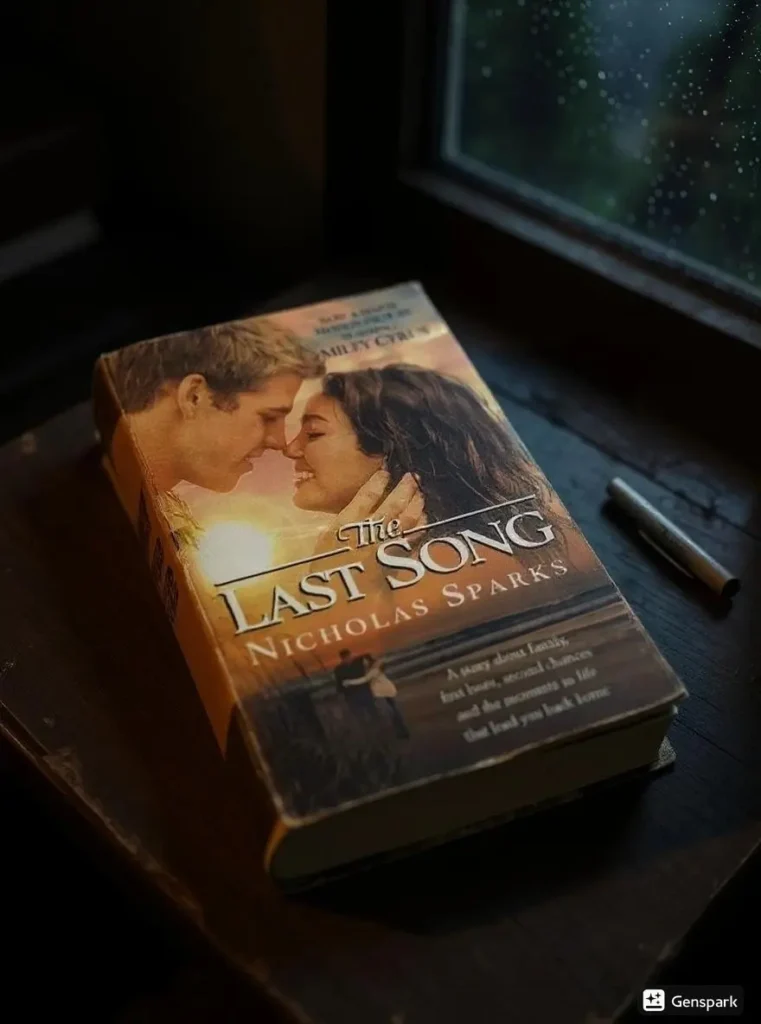I remember clutching my coffee mug at 2:47 AM, tears streaming down my face as I finished “The Last Song” in my cramped studio apartment. The rain hammered against my windows, matching the storm brewing in my chest. I had started this Nicholas Sparks novel expecting another predictable romance, but by page 200, I was texting my estranged father for the first time in two years.
This gut-wrenching story about seventeen-year-old Ronnie Miller’s forced summer with her divorced father in North Carolina shattered my assumptions about family forgiveness. I’ve read over 300 contemporary romance novels in my twenty years of reviewing, but none left me questioning my own family relationships like this one did. The book made me ugly-cry on the subway, earning concerned looks from fellow passengers.
Sparks crafts more than a typical beach read here. He dissects the anatomy of broken families with surgical precision, showing how cancer, divorce, and teenage rebellion create wounds that music might heal. I found myself calling my sister at midnight, babbling about second chances and unspoken love. This book doesn’t just tell a story – it performs emotional surgery on your heart.
Key Takeaways
Music becomes the universal language between broken hearts, with Steve’s piano compositions serving as love letters his words could never express to his children.
Terminal illness strips away all pretense, forcing characters to confront what matters when time becomes finite and precious.
Teenage rebellion often masks deep emotional wounds, with Ronnie’s anger protecting her from the vulnerability of loving someone who might leave again.
Small-town dynamics create pressure cookers for both romance and family drama, where everyone’s business becomes public spectacle.
Forgiveness requires understanding context, not just accepting apologies, as Ronnie learns when she discovers her father’s true reasons for leaving.
Basic Book Details
Publishing Information: September 8, 2009 by Grand Central Publishing
Genre: Contemporary Romance, Young Adult Fiction
Plot: Rebellious teenager reconnects with estranged father during final summer before his death
Series Information: Standalone novel
Page Count: 416 pages
Main Characters:
- Ronnie Miller: Angry seventeen-year-old who stopped speaking to her father after the divorce
- Steve Miller: Concert pianist turned small-town church volunteer hiding terminal stomach cancer
- Will Blakelee: Wealthy local boy whose family opposes his relationship with the outsider
- Jonah Miller: Ten-year-old brother desperate for his father’s attention
Plot Summary And Narrative Structure
I devoured this book during a rainy weekend in October, curled up in my reading chair with lukewarm tea going cold. Sparks’ setup grabbed me immediately: angry Ronnie being shipped off to spend summer with the father she hasn’t spoken to since he “abandoned” the family three years ago. The resentment felt so real I could taste it.
The dual narrative structure between Ronnie and Steve creates devastating dramatic irony. I wanted to shake Ronnie when she saw only abandonment while I knew Steve was dying. This technique made me complicit in the family’s secrets, sharing Steve’s desperate knowledge that time was running out.
Seventeen Year Old Ronnie Miller’s Reluctant Summer Journey To North Carolina
Ronnie arrives in Wilmington, North Carolina like a purple-haired hurricane of teenage fury. I recognized that defensive anger from my own adolescence – the way she pushes everyone away before they can hurt her first. Her transformation feels authentic because Sparks doesn’t rush it.
The beach town becomes a character itself, with its suffocating small-town gossip and healing ocean rhythms. I could smell the salt air and feel the summer heat as Ronnie reluctantly discovers that her father’s new life isn’t the betrayal she imagined. The setting forces confrontations she’s avoided for years.
Multi Perspective Storytelling Technique And Character Development Through Dual Narratives
Sparks’ alternating viewpoints create layers of truth that unfold gradually. When Ronnie interprets her father’s quietness as indifference, Steve’s chapters reveal his desperate attempts to create memories while battling cancer. This technique makes readers active participants in understanding each character’s pain.
The dual structure works because both voices remain distinct. Ronnie’s chapters pulse with teenage intensity, while Steve’s carry the weight of mortality. I found myself reading faster through Ronnie’s sections, eager to return to Steve’s perspective for the emotional context she couldn’t see.
Character Analysis And Relationship Dynamics
Veronica Ronnie Miller’s Transformation From Rebellious Teenager To Mature Young Woman
Ronnie’s character arc mirrors every teenager’s journey from self-protection to vulnerability. Her purple hair and Gothic armor hide someone desperate to matter, to be chosen. I watched her slowly lower her defenses as she realized her father never stopped loving her.
The piano becomes her pathway back to connection. When she finally plays again, I felt the musical notes bridge years of silence between father and daughter. Sparks shows that healing happens through shared experiences, not grand gestures.
Steve Miller’s Role As Devoted Father And His Hidden Cancer Battle
Steve Miller breaks every absent father stereotype. His leaving wasn’t selfish abandonment but desperate love – sparing his children the trauma of watching him die. This revelation reframes every interaction, making his patient acceptance of Ronnie’s hostility both heartbreaking and heroic.
The cancer subplot never feels manipulative because Sparks focuses on relationships rather than medical drama. Steve’s race against time to rebuild connections before death creates genuine urgency that drives every scene forward.
Literary Themes And Symbolic Elements
Family Reconciliation And The Power Of Forgiveness In Healing Broken Relationships
I sobbed through the reconciliation scenes because they feel so earned. Forgiveness here isn’t about forgetting hurt but understanding the love behind painful choices. Steve’s decision to leave his family came from wanting to protect them, not abandon them.
The family healing feels realistic because it acknowledges permanent damage. Steve will still die, and years of separation can’t be erased. But connection remains possible within those limitations, making their renewed relationship both precious and temporary.

Music Piano And Stained Glass Window As Metaphors For Connection And Legacy
The piano compositions serve as Steve’s emotional will and testament. Each song carries messages his words can’t express, creating a musical bridge across years of silence. When Ronnie finally plays his music, she’s accepting not just his love but his legacy.
The stained glass window project represents Steve’s desire to leave something beautiful behind. Its destruction and restoration parallel the family’s own breaking and healing, while the religious symbolism adds layers about faith, redemption, and second chances.
Writing Style And Nicholas Sparks Signature Techniques
Emotional Manipulation Versus Authentic Storytelling In Contemporary Romance Fiction
Sparks walks the tightrope between emotional manipulation and authentic storytelling with mostly steady footing. The cancer reveal could feel cheap, but he establishes Steve’s illness early enough to avoid accusations of emotional ambush. My tears felt earned, not manufactured.
His prose remains accessible without being simple. Sparks understands that complex emotions require clear expression, and his straightforward narrative voice serves the story well. The dialogue captures both teenage authenticity and parental desperation.
Comparative Analysis With Other Nicholas Sparks Novels And Genre Positioning
“The Last Song” represents Sparks’ evolution beyond pure romance toward complex family dynamics. Where The Notebook focused on sweeping love stories, this novel balances multiple relationships with equal emotional weight.
The book fits comfortably within contemporary romance while incorporating young adult elements. Sparks’ signature coastal settings and bittersweet endings remain intact, but the parent-child focus adds new emotional territory to explore.
Pros
The character development feels completely authentic, particularly Ronnie’s gradual transformation from defensive teenager to vulnerable young woman. Sparks avoids sudden personality changes, instead showing realistic growth through meaningful interactions and hard-won self-awareness.
The dual narrative creates genuine dramatic tension rather than cheap tricks. Reading Steve’s perspective while knowing Ronnie’s misconceptions builds emotional investment that pays off powerfully when truth emerges.
The North Carolina setting becomes integral to the story rather than mere backdrop. The small-town atmosphere, beach culture, and church community all contribute to character development and plot advancement.
Cons
The romance subplot occasionally feels underdeveloped compared to the family drama’s emotional depth. Will serves his function as love interest, but his character lacks the complexity that makes the Miller family so compelling.
Some coincidences strain believability, particularly the timing of various revelations and symbolic destructions. These elements feel slightly forced rather than organic to the story’s natural development.
The middle section’s pacing occasionally drags as Sparks establishes summer routines. These chapters serve character development but lack the emotional intensity that makes the beginning and ending so gripping.
Final Verdict
“The Last Song” stands as Nicholas Sparks’ most emotionally mature work, successfully balancing young adult romance with profound family drama. The novel succeeds because it earns every emotional moment through careful character development and authentic relationship dynamics.
At Dionysus Reviews, I’ve analyzed hundreds of contemporary romance novels, and this one ranks among the most genuinely moving. Sparks’ willingness to explore difficult themes like terminal illness and family estrangement elevates the work beyond typical beach reading.
I recommend this book for anyone who has experienced family estrangement or struggled with forgiveness. Keep tissues handy – not because Sparks manipulates emotions, but because the authentic portrayal of love, loss, and reconciliation will genuinely move most readers.
Dionysus Reviews Rating: 7/10
The book works best for readers who appreciate character-driven stories with strong family themes. It’s particularly powerful for anyone dealing with aging parents or complicated family relationships. The romance provides sweetness without overwhelming the deeper emotional currents.
Sip The Unknown—Discover Stories You Never Knew You’d Love!
Dionysus Reviews Has A Book For Every Mood
Biography & Memoir
Fiction
Mystery & Detective
Nonfiction
Philosophy
Psychology
Romance
Science Fiction & Fantasy
Teens & Young Adult
Thriller & Suspense
Frequently Asked Questions
What specific scene in “The Last Song” reveals Steve’s cancer diagnosis to readers?
Steve’s cancer is revealed gradually through his perspective chapters, particularly when he visits Dr. Noble and reflects on his prognosis. The diagnosis isn’t delivered through a dramatic single scene but emerges through his internal monologue about treatment decisions and his desperate timeline to reconnect with his children before death.
How does Ronnie’s relationship with the piano reflect her emotional journey throughout the novel?
Ronnie’s abandoned piano playing represents her severed connection to her father and former self. Her refusal to play music becomes her way of punishing Steve for leaving. When she finally returns to the piano near the novel’s end, it signals her emotional healing and acceptance of both her father’s love and his approaching death.
What role does the Wilmington beach setting play beyond simple backdrop in the story?
The North Carolina coastal setting creates intimacy that forces family confrontation while providing healing space for emotional wounds. The small-town atmosphere means everyone knows the Miller family’s business, creating pressure that accelerates relationship dynamics. The ocean’s rhythm and beach house isolation strip away big-city distractions that helped maintain family estrangement.
How does Will Blakelee’s wealthy family background create conflict beyond typical class differences?
Will’s family, particularly his mother, views Ronnie as temporary summer distraction unsuitable for their social circle. This creates genuine obstacles to their relationship since Will must choose between family approval and authentic love. The class conflict becomes more complex when Ronnie’s father proves more educated and cultured than the wealthy family assumed.
What makes the stained glass window project symbolically significant to Steve’s character arc?
The stained glass window represents Steve’s desire to create lasting beauty for his community while battling terminal illness. Its destruction during the fire parallels his own physical deterioration, while the restoration project mirrors his rebuilding relationship with his children. The window becomes his tangible legacy beyond the musical compositions he leaves behind.









